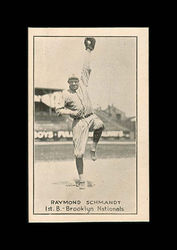

Tobacco & Candy Cards
Although baseball cards had been given away with tobacco products before, the practice exploded in popularity in 1909 when small and colorful cards were inserted into packs of cigarettes. The frenzy was noted by newspapers, which described how boys would loiter around tobacco shops and pester customers for cards. The popularity of cards coincided with the game's rise in stature during the Dead Ball Era, when Americans embraced new heroes like Ty Cobb, Christy Mathewson and Honus Wagner.

A slew of candy companies came out with cards in 1909, including American Caramel, National Caramel, Philadelphia Caramel and Dockman & Sons. Here are two players, Tommy Leach and Davy Jones, whose stories in The Glory of Their Times have long intrigued baseball fans. Also pictured are Hall of Famer Mordecai "Three Finger" Brown, Hall of Famer Hughie Jennings (doing his famous "Ee-Yah!" dance) and Marty McIntyre, who feuded famously with teammate Ty Cobb.

Around the same time that candy companies began producing cards, the American Tobacco Company came out with the first of what would one day be called by collectors the T-206 set. Over the next three years, the company issued 524 different cards, along with countless variations and front-back combinations. The backs feature ads for 16 different tobacco brands, while the fronts showcase a wide assortment of major and minor league players, including most of the stars of the day. Pictured here are Hall of Fame inductees John McGraw, Willie Keeler, Sam Crawford, Clark Griffith, Miller Huggins, Rube Waddell and Zack Wheat.

Besides the iconic T206 set, tobacco companies produced a variety of sets, including a few pictured here: 1911 Mecca Double Folders (T201), 1912 Hassan Triple Folders (T202) and Turkey Red Premiums (T3). Included here are cards of some of the game's greatest players, including Hall of Famers Ty Cobb, Christy Mathewson, Tris Speaker and Fred Clarke, along with Eddie Cicotte of Black Sox Fame.

In California, Oregon and Washington from 1909 to 1911, Obak Cigarettes were sold with cards of Pacific Coast League and Northwest League players. The artwork is exquisite — some cards resemble miniature Impressionist paintings. Pacific Coast Biscuit and Zeenuts (the last two pictured here), also made cards of PCL players.

Board games and card games were popular during the Deadball Era, giving fans a way to connect with the sport during any weather or time of day. Four Hall of Famers are pictured here — Nap Lajoie, Walter Johnson, Ed Walsh and Rube Marquard — along with Nap Rucker, a fine lefty hurler who came from Georgia.

In 1914 and 1915, Cracker Jacks came out with one of the most iconic of baseball card sets. Included in it are not only baseball's biggest stars of the era, but also those who played in the short-lived Federal League. While the company never did another great card set, its patented confection of caramel-coated popcorn and peanuts was a big hit at the ballpark, as evidenced by the reference to it in the game's grand old song, "Take Me Out to the Ball Game." "Our first set is 10,000,000 pictures" reads a line on the back of each card. Its truly remarkable how few survived, perhaps due to wartime paper drives — each costs a small fortune today.

A new style of a card appeared in 1916. The colorful artwork of the tobacco card era was replaced by black and white photography. Although the first of the cards displayed here are generally associated with the Sporting News, their backs display advertisements for a variety of companies. The Sporting News cards paved the way for similar sets produced by American Caramel and National Caramel in the early 1920s. Examples of Hall of Famers Frank "Home Run" Baker, Herb Pennock, Waite Hoyt and Harry Hooper are presented below. The 1920s also saw the debut of postcard-sized Exhibit cards, which were made with thick cardboard and distributed through vending machines by Exhibit Supply Co. of Chicago.

© 2024






















































































